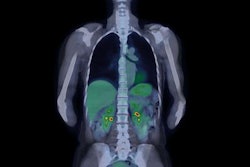
The European Society of Radiology (ESR) is set to welcome the European Society for Hybrid Medical Imaging (ESHI) under its umbrella, in line with efforts to increase training in nuclear medicine. The official launch is due to take place at ECR 2016, held in Vienna in early March.
Improving patient care lies at the heart of the new society, and this can be enhanced by optimizing the use of hybrid imaging by using both the PET and CT or MR part for diagnostic purposes, which is not always done today, ESHI President Dr. Katrine Riklund told AuntMinnieEurope.com in an interview.
Combining nuclear medicine and advanced imaging such as CT and MRI is becoming increasingly crucial in the routine staging of oncologic disease, treatment planning, and follow-up, she added. The molecular, biochemical, and structural information that hybrid imaging reveals is advantageous when compared with the separate data provided by each technique on its own and it can optimize management of cancer patients, particularly those suffering from solid cancers and lymphoma.
 With continuous education, most hybrid examinations should be read by one specialist in the future, Dr. Katrine Riklund said. Image courtesy of ESR.
With continuous education, most hybrid examinations should be read by one specialist in the future, Dr. Katrine Riklund said. Image courtesy of ESR.However, radiologists in training across Europe systematically report that more cross-over training is needed to educate the next generation of imaging specialists in PET/MR, PET/CT, and SPECT/CT, according to Riklund, who is also president of ECR 2016 and professor of radiology and nuclear medicine at University Hospital of Umeå in Sweden. Often, two specialists each generate a report, and the goal for the future is to have one imaging specialty that includes hybrid imaging.
The sum of the whole would be greater than its parts, which is good for the patient, and such a strategy provides a much fuller picture about the disease, she noted.
"In some countries, the nuclear medicine specialists read the PET images while the radiologist reads the CT or MRI, but in Umeå, all physicians working with hybrid imaging are dual licensed in radiology and nuclear medicine, and we also always use all the previous radiological and nuclear medicine imaging information for comparison to make one report of the hybrid imaging study," she said. "Hybrid imaging gives more information than only structural or only molecular/functional imaging in several cancers, which facilitates better decisions in treatment and a more accurate idea of prognosis."
Priorities of the new society
Although the society is still very much in its infancy, its goals are clear: to promote education in hybrid imaging and ensure the best use is made of PET/CT and PET/MR.
The creation of ESHI is the fruit of several years of discussion. In 2007, the ESR published a white paper in multimodality imaging, together with the European Association of Nuclear Medicine (EANM). In 2011, the multimodality imaging training curriculum, written by the ESR and the EANM, and published in the journal Insights into Imaging, set out an appropriate knowledge base in multimodality imaging to help practitioners provide the highest quality of patient care. The goal was to advance the quality of performance and reporting of hybrid imaging by defining the scope of training for medical specialists.
In November 2014, a session about hybrid imaging training was held during the Annual Leadership Meeting of the ESR's member societies. The vast majority of the attendees supported the idea of establishing a European society for hybrid imaging, according to a statement released by the ESR. Radiology residents have also shown a strong desire to increase their training in nuclear medicine, as revealed by a survey conducted by the ESR Radiology Trainees Forum among all ESR members in training in December 2014 to early 2015.
ESHI will spearhead training days covering hybrid topics through the European School of Radiology (ESOR), and they will take place at various locations during 2016. In addition, other professional issues such as exam protocols, equipment use, and science will come under the spotlight. ESHI will also enjoy a strong Web presence through a dedicated site and members will benefit from interactive tutoring through ESR's existing e-learning portal with ESHI topics connected to the European Training Curriculum for Radiology.
Membership enquiries have come from radiologists, nuclear medicine specialists, physicists, preclinical researchers, nurses, and radiographers, Riklund pointed out.
"The focus is on ensuring optimal use of hybrid imaging for best patient care. It is important to take advantage of both structural and molecular information in each examination and, with continuous education, most hybrid examinations should be read by one specialist in the future. The intention is to establish a collaborative relationship between radiology and nuclear medicine," she said. "All colleagues working or aiming to work with hybrid imaging techniques are welcome to become members of the new society. We will also continue to collaborate with other societies, such as the EANM."
Given the existence of societies such as EANM and the European Society of Molecular Imaging, it remains unclear how large ESHI's membership will be, but Riklund remains optimistic about the future.
"There may be some overlap of membership between societies; I, for example am a member of both ESR and EANM. However, there is increasing discussion of hybrid imaging and its role in high-end work-up, so ESHI could become a big society," she said.



















